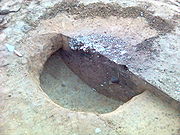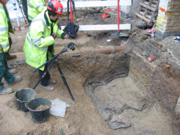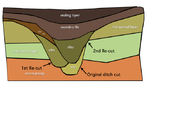
Cut (archaeology)
Encyclopedia

Archaeology
Archaeology, or archeology , is the study of human society, primarily through the recovery and analysis of the material culture and environmental data that they have left behind, which includes artifacts, architecture, biofacts and cultural landscapes...
and archeological stratification a cut or truncation is a context
Archaeological context
In archaeology, not only the context of a discovery is a significant fact, but the formation of the context is as well. An archaeological context is an event in time which has been preserved in the archaeological record. The cutting of a pit or ditch in the past is a context, whilst the material...
that represents a moment in time when other archaeological deposits were removed for the creation of some feature
Feature (archaeology)
Feature in archaeology and especially excavation has several different but allied meanings. A feature is a collection of one or more contexts representing some human non-portable activity that generally has a vertical characteristic to it in relation to site stratigraphy. Examples of features are...
such as a ditch or pit. In laymans terms a cut can be thought of a hole that was dug in the past, though cut also applies to other parts of the archaeological record
Archaeological record
The archaeological record is the body of physical evidence about the past. It is one of the most basic concepts in archaeology, the academic discipline concerned with documenting and interpreting the archaeological record....
such as horizontal truncations like terraced ground. A cut context is sometimes referred to as a "negative context" as opposed to a "positive context". The term denotes that a cut has removed material from the archaeological record or natural
Archaeological natural
Natural in archaeology is a term to denote a horizon in the stratigraphic record representing the point before which there is no anthropogenic activity on site and the archaeological record ends. Natural is often the underlying geological makeup of the site and is formed by geological processes...
at the time of its creation as opposed to a positive context which adds material to the archaeological record. A cut has zero thickness and no material properties of its own and is defined by the limits of other contexts. Cuts are seen in the record by virtue of the difference between the material it was cut through and the material that back fills it. This difference is seen as an "edge" by the archaeologists on site. This is shown in the picture above (Fig 1.), where a half sectioned
Archaeological section
In archaeology a section is a view in part of the archaeological sequence showing it in the vertical plane, as a cross section, and thereby illustrating its profile and stratigraphy. This may make it easier to view and interpret as it developed over time....
Saxon pit has had half its backfill
Fill (archaeology)
In archaeology fills are contexts representing material that has accumulated or has been deposited into a cut feature such as ditch or pit of some kind...
removed and we can clearly see a difference between the ground the pit was cut into and the material originally filling the pit . Sometimes these differences are not clear and an archaeologist must rely on experience and insight to discover cuts.
Re-cuts

Sequence (archaeological)
The archaeological sequence or sequence for short, on a specific archaeological site can be defined on two levels of rigour.# Normally it is adequate to equate it to archaeological record. However, the two terms are not exactly interchangeable...

Hypothetical ditch re-cuts shown in section
Fig 2 shows how a ditch re-cut with at least two re-cuts may appear when viewed in sectionArchaeological section
In archaeology a section is a view in part of the archaeological sequence showing it in the vertical plane, as a cross section, and thereby illustrating its profile and stratigraphy. This may make it easier to view and interpret as it developed over time....
. It is possible that numerous other re-cuts took place and were truncated out of the archaeological record
Archaeological record
The archaeological record is the body of physical evidence about the past. It is one of the most basic concepts in archaeology, the academic discipline concerned with documenting and interpreting the archaeological record....
by one or more of the re-cuts that has survived.
See also
- Single context recordingSingle context recordingSingle context recording was initially developed by Ed Harris and Patrick Ottaway in 1976, from a suggestion by Lawrence Keene. It was further developed by the Department of Urban Archaeology from where it was then exported, in the mid 1980s by Pete Clarke to the Scottish Urban Archaeological...
- Harris matrixHarris matrixThe Harris matrix is a tool used to depict the temporal succession of archaeological contexts and thus the sequence of deposition on a 'dry land' archaeological site. The matrix reflects the relative position and stratigraphic contacts of observable stratigraphic units, or contexts. The Matrix was...
- Archaeological planArchaeological planAn archaeological plan in an archaeological excavation, is a drawn record of features in the horizontal plane.- Overview :Archaeological plan can either take the form of...
- Archaeological associationArchaeological associationAssociation in archaeology has more than one meaning and is confusing to the layman. Archaeology has been critiqued as a soft science with a somewhat poor standardization of terms.-Finds and objects:...
- Relationship (archaeology)Relationship (archaeology)An archaeological relationship is the position in space and by implication, in time, of an object or context with respect to another. This is determined, not by linear measurement but by determining the sequence of their deposition - which arrived before the other...
- Archaeological contextArchaeological contextIn archaeology, not only the context of a discovery is a significant fact, but the formation of the context is as well. An archaeological context is an event in time which has been preserved in the archaeological record. The cutting of a pit or ditch in the past is a context, whilst the material...
- Archaeological sectionArchaeological sectionIn archaeology a section is a view in part of the archaeological sequence showing it in the vertical plane, as a cross section, and thereby illustrating its profile and stratigraphy. This may make it easier to view and interpret as it developed over time....
- Feature (archaeology)Feature (archaeology)Feature in archaeology and especially excavation has several different but allied meanings. A feature is a collection of one or more contexts representing some human non-portable activity that generally has a vertical characteristic to it in relation to site stratigraphy. Examples of features are...
- Fill (archaeology)Fill (archaeology)In archaeology fills are contexts representing material that has accumulated or has been deposited into a cut feature such as ditch or pit of some kind...
- Alignment (archaeology)Alignment (archaeology)An alignment in archaeology is a secondary or circumstantial form of evidence used to associate features such as postholes by virtue of their physical relationships rather than stratigraphic ones...

